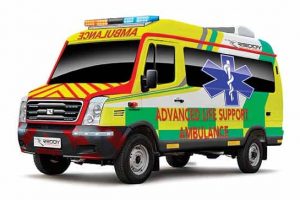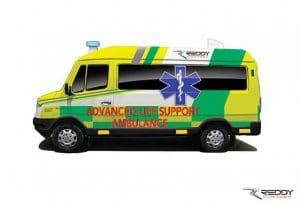Reddy Customs has entered the medical vehicle sector.
Story by Deven Lad
Pune-based Reddy Customs has been in the commercial vehicle bodybuilding industry for the last 20 years. It has built vanity vans, office-on-wheels and motorhome type of bodies on trucks, buses and vans. Gauging the rising potential of the medical vehicle sector, it has taken to building ambulances. It has built 20 ambulances on the Force Traveller chassis and is building another 280 ambulances. These conform to the National Ambulance Code (AIS-125) and would be supplied to various hospitals in the current financial year. To provide 300 Force tempo traveller 3350 high-tech ambulances in total in the current financial year according to Srinivas Reddy, CEO, Reddy Customs, the ambulances will help to address the emergency infrastructure gap. The ambulances are expected to address the gaps exposed by the Covid-19 pandemic as it spreads across India and ravaged mega cities as well as smaller cities and towns alike.
Taking the decision to enter the ambulance building space after witnessing the rise in mortality rate due to the unavailability of ambulances to take the patient to the medical centre in time, Reddy averred that he was also moved by the undue advantage taken by private ambulance service providers by charging heavily during the pandemic. Known to overcharge the needy even at other times, private ambulance operators have been taking advantage of the shortfall in ambulances despite many efforts being undertaken to address this problem. Of the opinion that the medical vehicle sector was ignored by OEs and various other stakeholders in the commercial vehicle industry for some reason or the other, Reddy is clear about the type of ambulances his enterprise would build and supply to. In this regard, Reddy Customs is approaching hospitals and investors.
Confident of offering its high-tech ambulances at highly competitive rates, Reddy is talking to various companies with a vision to create an ambulance network that is well connected and highly effective in addressing the needs of the end-user. Taking to build ambulances in the Force Tempo Traveller T1 chassis with a seating capacity of 10 people apart from the patient, Reddy Customs is paying attention to the operating as well as the maintenance part as well. It is keen to ensure that the ambulances it offers do not lead to high maintenance and running costs. It has, in this regard, decided to not touch the drivetrain or the driveline, which it feels is robust and highly reliable. The 115hp, 2.6-litre common-rail diesel engine mated to a five-speed gearbox is thus the basis for the ambulances. Reddy Customs is also not in favour of carrying out excessive changes to the monocoque structure of the vehicle.
Economies of scale?
Refraining from modifying the suspension either, and in the interest of reliability and cost, Reddy Customs is concentrating on a high-tech ambulance that is low on cost. Stating that a typical ambulance that they have taken to build will cost no less than Rs.17 lakh, Reddy explained that their endeavour is to offer ambulances at a far more competitive price. To achieve this without crimping on the essentials is going to be tough no doubt, Reddy Customs, however, is confident. It is confident that it would be able to offer its ambulances at a cheaper rate to hospitals. With 20 ambulances at various stages of manufacture, Reddy Customs is also ironing out any teething troubles that are coming its way as it gears up to mass-produce such vehicles. With an eye on achieving economies of scale, the company is building the ambulances under Automotive Research Association of India (ARAI) guidelines.
The ARAI guidelines classify ambulances in categories like medical first responder, basic life support ambulance and advanced life support ambulance. Claiming to be capable of building either type of ambulance as per the need of the buyer, Reddy Customs is accordingly making the necessary changes to its infrastructure at Chakan. To provide in-built sanitisation system for hygiene and safety, the ambulances the company is building, will be highly effective in their duty, announced Reddy. He said, “Our two demo ambulances will prove this point. We will take them to hospitals and even let those who we feel are potential buyers to experience them.” Keen to ensure that the ambulances it builds provide real-life and real-time benefit to the end-users as much as they support the business of their operators, Reddy Customs is taking a very cautious approach to what features and facilities should be incorporated and what should be left out. Of the opinion that there is no point in providing facilities or features that are hardly used and in the process increase the weight of the vehicle, it is best to concentrate on facilities that are prime to an ambulance, mentioned Reddy.
The right ambulance
Featuring an exhaust fan, wash basin, a cabinet for storing medical consumables, separate doctor’s seat with a lap belt, squad bench for paramedic staff or relatives, sidewalls reinforced to mount ventilators, suction pumps, among others, Reddy Custom carried out a survey about how well-equipped many existing ambulances are. What they found startled them. They found out that a majority of ambulances available with the hospitals are not well-equipped. They also found out that the ambulances lacked proper facilities onboard. After a considerable evaluation of what the current ambulances offer and what is necessary, the company decided to enter the space and build high-tech ambulances that are also cost-competitive. Said Reddy, “We are making sure that the ambulances we build will be of superior quality and have the latest technology in terms of equipment.”
Conducting an audit of its infrastructure in regard to the plan to mass-produce ambulances, Reddy Customs is at the other end talking to as well as consulting various stakeholders in an attempt to anticipate the future of such vehicles. Of the opinion that the current manufacturing facilities are unable to support the demand for manufacture of the number of ambulances needed, Reddy quipped that there is immense scope of new players to enter the space and produce quality ambulances. Drawing attention to the National Ambulance Service, under which the government runs close to 25,000 units in India, Reddy averred that the number of ambulances run by private operators, social and political organisations, and NGOs amount to a little over 10,000 units. Announcing that there is an acute shortage of ambulance service in the country, he said that theirs is not a profit-making project. “It is service-oriented and being pursued in the interest of proper medical facilities being given,” Reddy added. Against the backdrop of the pandemic and how it has exposed some of the worst flaws of our health care mechanism, players like Reddy Customs are poised to once again highlight the role of CVs — albeit special application CVs, in the smooth running of this country.























